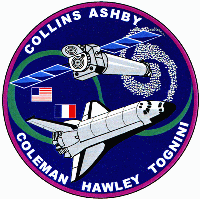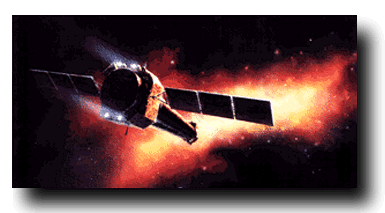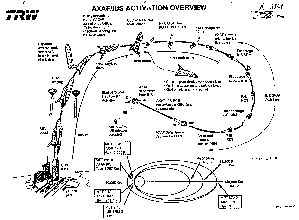

Crew - Vehicle - Images - Press Releases - Links - Deployment - Milestones


The Advanced X-ray Astrophysics Facility (AXAF) will be launched on Space Shuttle mission STS-93. In Dec 1998 AXAF was named the Chandra X-ray Observatory after physicist Subrahmanyan Chandrasekhar Chandra is a mission in NASA's SEU (Structure and Evolution of the Universe) program. As a user of the Chandra Observatory, I'm providing this page to keep my fellow guest observers and other interested folks up to date with the progress of the mission.
| Commander: | Lt-Col. Eileen Collins, USAF, NASA |
| Pilot: | Cmdr. Jeff Ashby, USN, NASA |
| Mission Specialist: | Dr. Steven Hawley, NASA |
| Mission Specialist: | Dr. Cady Coleman, Maj. USAF, NASA |
| Mission Specialist: | Col. Michel Tognini, AAF, CNES |
| Component | Name/Serial | Status |
|---|---|---|
| Launch Complex | LC39B | Refurb |
| Solid Rocket Motors | RSRM-69 | Being towed to port |
| External Tank | ET-99 (Super Light Weight Tank) | Reentered over Pacific? |
| Orbiter | OV-102 Columbia | In orbit |
| Payload Bay Cargo | IUS Tilt Table | Aboard Columbia |
| Upper Stage | Inertial Upper Stage IUS-27 | In orbit |
| Spacecraft | Chandra X-Ray Observatory (AXAF) | In transfer orbit |
| . | . | ETE-1 test completed 2/98 |
| . | . | Final assembly completed 3/98 |
| . | . | Thermal vac testing complete 7/98 |
| . | . | ACIS/SIM retest 8/98 |
| . | . | Undergoing tests at TRW 10/98 |
| . | . | Arrived KSC 2/99 |
| . | . | Fuelled 4/99 |
| . | . | Mate to IUS-27 6/99 |
| . | . | Transfer to pad 39B 6/99 |
| . | . | In Columbia, Jun 27 |
| . | . | Launch Jul 23 |
| . | . | Deploy and IUS burns, Jul 23 |
| Time (UTC) | Event | Description | Orbit (perigee x apogee, km) |
|---|---|---|---|
| Jul 23 0431 | Launch | RSRM ignition, liftoff | . |
| Jul 23 0433 | SRB Sep | RSRM burnout, separation | . |
| Jul 23 0439 | MECO | Main engine cutoff | . |
| Jul 23 0439 | ET Sep | External Tank separation | 78 x 276 |
| Jul 23 0512 | OMS-2 | OMS orbit circ burn | 320 x 320 |
| Jul 23 0610 | PLBD | Payload bay doors open | . |
| Tilt | Raise tilt table to 4 deg | . | |
| Jul 23 1000? | Tilt | Raise tilt table to 29 deg | . |
| . | Chandra to internal power | . | |
| Jul 23 1142 | Tilt | Raise tilt table to 58 deg | . |
| Jul 23 1147 | Deploy | Chandra/IUS-27 deploy | 320 x 320 |
| Jul 23 1248 | SRM-1 | IUS-27 SRM-1 burn | . |
| Jul 23 1250 | SRM-1 cutoff | IUS-27 SRM-1 sep from SRM-2 | 320 x ? |
| Jul 23 1251 | SRM-2 | IUS-27 SRM-2 burn | . |
| Jul 23 1253 | SRM-2 cutoff | IUS-27 SRM-2 cutoff | 320 x 72000 |
| Jul 23 1322 | SA Deploy | Chandra solar panels deploy | . |
| Jul 23 1350 | SRM-2 sep | IUS-27 SRM-2 sep from AXAF | . |
| Jul 25 0111 | IPS-1 | IPS burn 1, apogee | 1200 x 72000 |
| Jul 26 0145 | IPS-2 | IPS burn 2, perigee | |
| Jul 31 2227 | IPS-3 | IPS burn 3, apogee | |
| Aug 2 0446 | IPS-4 | IPS burn 4, apogee? | |
| Aug 4 2027 | IPS-5 | Trim burn, apogee |
(Thanks to Wallace Tucker for this information)
| Milestone | Date |
|---|---|
| HEAO-LOXT proposal | 1970 |
| HEAO descoped | 1973 |
| AXAF phase A study | 1978 |
| AXAF phase B study | 1985 |
| Technology mirror (TMA) tested | 1985 |
| Approved as new start | 1988 |
| TRW chosen as contractor | 1988 |
| SAO/MIT chosen as AXAF science center | 1991 |
| AXAF rescoped into AXAF-I and AXAF-S | 1992 |
| AXAF-S cancelled | 1993 Oct |
| HRMA complete | 1996 |
| Mirror calibration | 1996 Dec - 1997 Feb |
| Instrument calibration | 1997 Feb-May |
| Spacecraft assembly | 1998 Mar |
| Thermal vac tests | 1998 Jun |
| End-to-end tests | 1998 Jul |
| AXAF named Chandra X-ray Observatory | 1998 Dec |
| AXAF arrive at KSC | 1999 Feb |
| IUS mate to AXAF | 1999 Jun |
| AXAF/IUS transfer to Columbia | 1999 Jun |
| Launch | 1999 Jul |

Chandra launch and deployment sequence. The IPS burn times on this picture are out of date.
Chandra in Shuttle payload bay
Chandra in Shuttle payload bay
Chandra exploded view
Questions and corrections: email Jonathan McDowell at jcm@cfa.harvard.edu.